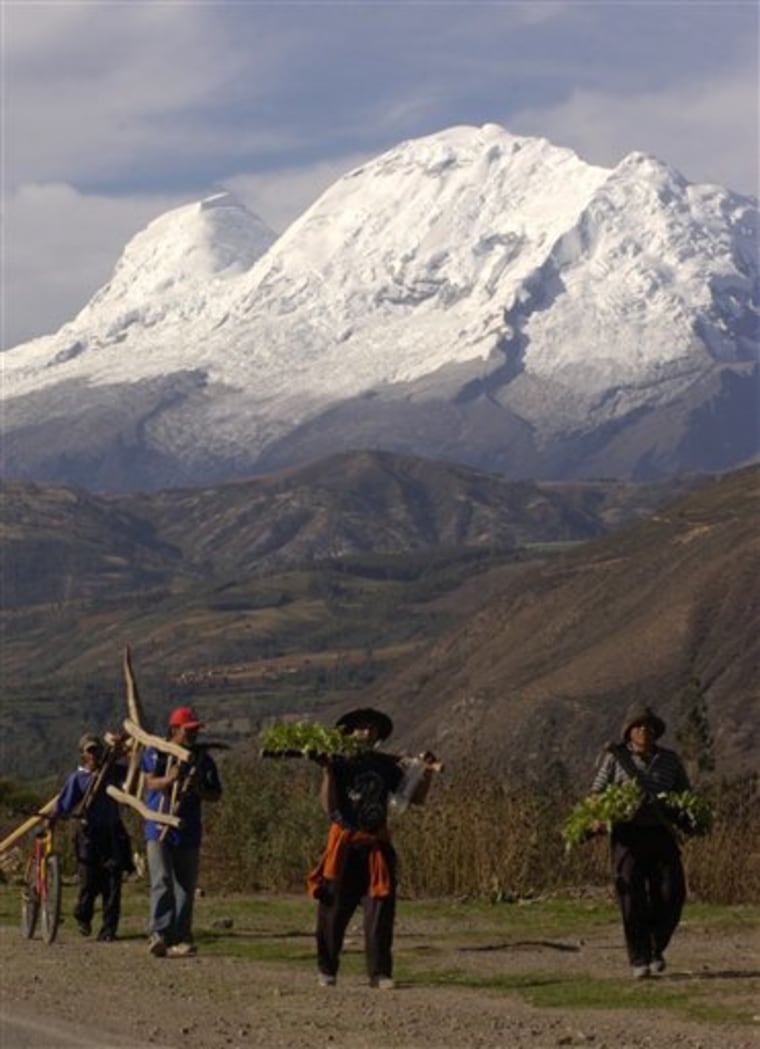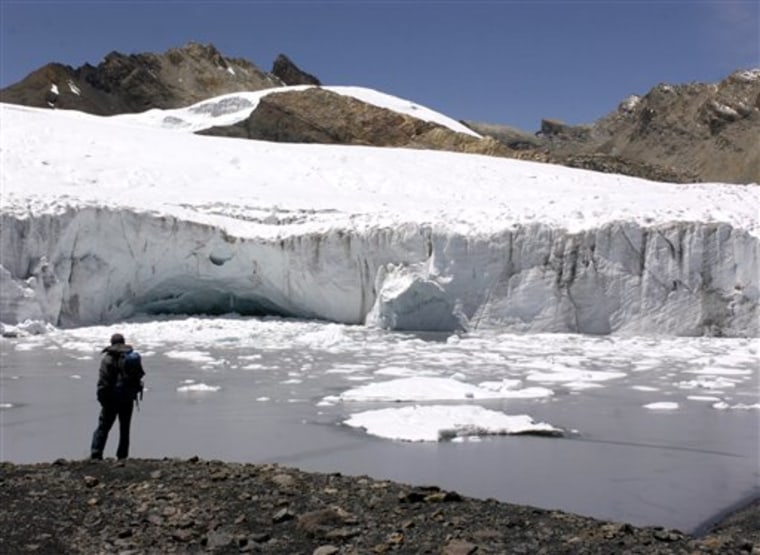Peru's "White Mountain Range" may soon have to change its name.
The ice atop Cordillera Blanca, the largest glacier chain in the tropics, is melting fast because of rising temperatures, and peaks are turning brown. The trend is highlighting fears of global warming and, scientists say, is endangering future water supplies to the arid coast where most Peruvians live.
Glaciologists consider the health of the world's glaciers an indicator of global warming and they warn that what is happening in the Andes signals trouble ahead.
"To me it's the rate of ice loss that's a real concern," because when melting accelerates, the ice cannot replenish itself, said Lonnie Thompson, a leading glacier expert at Ohio State University.
Thompson, a geologist monitoring glacier retreat on the Andes, Himalayas and Kilimanjaro, said tropical glaciers are melting all over the world because of rising temperatures "and where we have the data to prove it, the rate of ice loss is actually accelerating."
Quelccaya in southern Peru, the world's largest tropical ice cap, is retreating at about 200 feet a year, up from 20 feet a year in the 1960s, Thompson said.
Neighbors face same issue
Melting is also visible in the other Andean countries:
- BOLIVIA: Glacier melt has accelerated significantly since 1980, says Jaime Argollo Bautista, director of the Institute of Geological Investigation at Bolivia's University of San Andres. He predicts the country's glaciers will disappear in 30 to 40 years.
- ECUADOR: Glaciologist Luis Maisincho says he's noticed ice melting rapidly atop Cotopaxi, an active volcano whose 19,000-foot snowcapped peak can be seen from the capital, Quito, 40 miles to the northwest.
- COLOMBIA: Snowcaps are receding at an average rate of 80 feet a year, an increase from about 50 feet just a few years earlier, according to hydrologist Carlos Costa.
- VENEZUELA: The high peaks of the Sierra Nevada of Merida range show some glaciers have entirely disappeared over the past several decades, while others have shrunk significantly.
Ice caves disappear
In Peru, home to 70 percent of Earth's tropical glaciers, the Andes mountains have lost at least 22 percent of their glacier area since 1970 and the melt is speeding up, according to Peru's National Resources Institute, INRENA, a government agency.
Rock shows through lavishly snow-covered mountains throughout the Peruvian Andes. The Broggi glacier has disappeared altogether. Ice caves once popular with tourists are gone.
On Cordillera Blanca, which has 35 percent of Peru's glaciers, Marco Zapata, head of INRENA's glaciology unit, trudges up a barren, rocky mountain slope that until recently was covered by a centuries-old layer of ice. He points to a small, white mound on the retreating Pastoruri glacier, 17,000 feet above sea level.
A month earlier, that mound was an ice cave — Pastoruri's last — until the cavern's crystalline arch collapsed under an unseasonably warm sun. The remnants are melting into a newly formed lagoon.
The number of ice caves varies from year to year as temperatures rise and fall. But Pastoruri's ice cap shrank nearly 40 percent between 1995 and 2005, and Zapata, who has studied Peru's glaciers for 36 years, says postcards of the caverns should be taken off the market.
Water concerns
Meanwhile, the melt is causing long-term fears of a water shortage.
Glaciers feed the rivers that feed the sprawling cities and shantytowns on Peru's bone-dry Pacific coast. They also serve agriculture and hydroelectric plants that generate 70 percent of the country's power.

Two-thirds of Peru's 27 million people live on the coast, where just 1.8 percent of the nation's water supply is found. Shantytowns spring up virtually overnight in the steep, sandy dunes around the capital, Lima, and providing them with water is extremely costly, says Julio Garcia of the National Environment Council, CONAM.
President Alan Garcia believes the rush of melted water could provide abundant hydroelectric energy to Peru and its neighbors, and CONAM'S Garcia agrees it's feasible, but doesn't think the water bonanza will last beyond 2050.
Zapata says the warming of Cordillera Blanca combines with four years of below-average rainfall. "There is no regularity in terms of seasons," he said on a blindingly sunny day in what is traditionally the Andean rainy season. "The farmers are completely confused."
Farmers growing potatoes, wheat and artichokes depend entirely on the glacier runoff from the Cordillera Blanca during the dry season, and on rainfall during the wet season, and they say this is changing.
"There's less now, not like before," Claudia Villafan Ramos, a farmworker, said of the snows atop the mountain in her native Santa River valley. The peaks are now spotted with bare brown patches.
Villfan, whose weathered hands and face make her look older than her 42 years, said it means fewer jobs and "there is nothing to eat."
